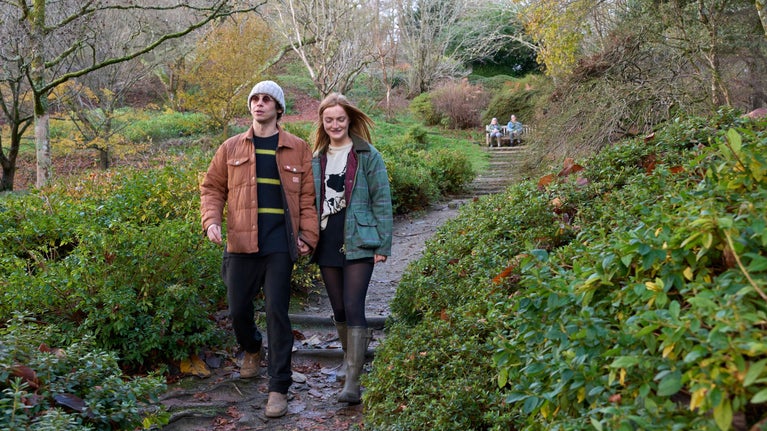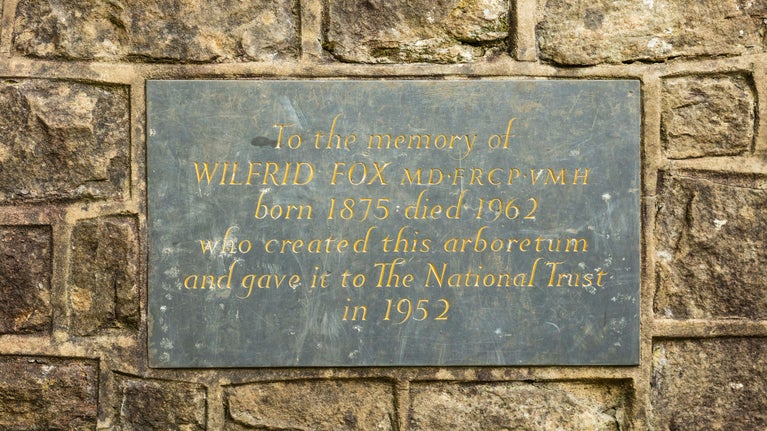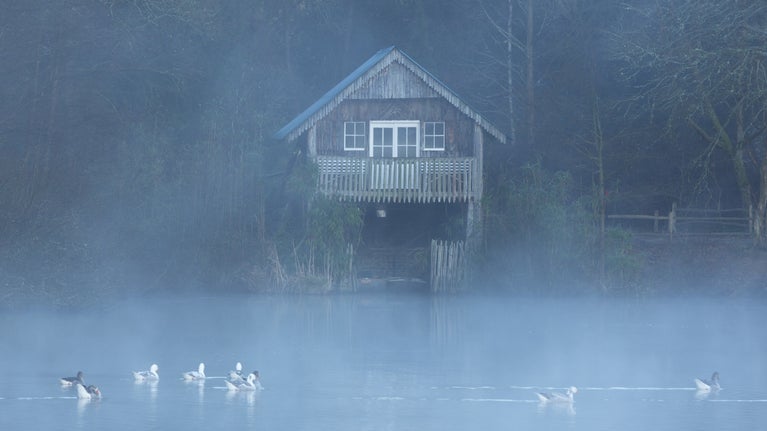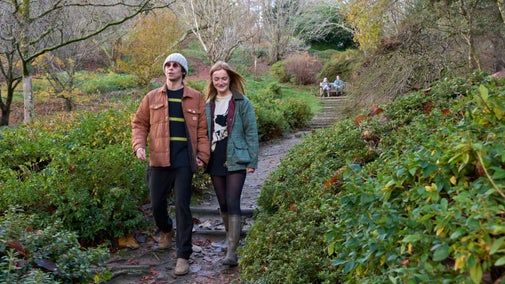
Discover more at Winkworth Arboretum
Find out how to get to Winkworth Arboretum, where to park, the things to see and do and more.

Winkworth Arboretum, Surrey, is an experiment of riotous colour. The arboretum is the vision of Dr Wilfrid Fox – a physician, businessman and horticulturalist – who created a landscape with trees as a painter would with a brush.
Winkworth is located on land that has archaeological evidence of prehistoric and Roman activity. From the 13th century it was owned by a succession of local families as part of the manor of Thorncombe, Bramley.
In 1849, Captain Edward Rowe Fisher-Rowe (1832–1909) bought the estate, living with his family at nearby Thorncombe House and Park. Edward’s only surviving son, Herbert Mayow Fisher-Rowe, sold the entire 880-acre Thorncombe estate in 1937 to Eleanor Williamson, Countess Peel (1871–1947) who in turn divided the estate into 27 lots auctioned in the same year.
Dr Wilfrid Stephen Fox (1875–1962), a physician and dermatologist, lived at Winkworth Farm, Godalming with his wife Nereida Florence Nugent Petrie (c.1869–1945) and their family. Wilfred retired from medicine in 1926, becoming a founding member and secretary of the Roads Beautifying Association that supported initiatives to improve planting alongside motorways. This earned him the Victoria medal of the Royal Horticultural Society (RHS). He also turned to business, becoming partner and subsequent Chairman in 1939 of his family’s firm, Duncan, Fox & Co., an import and export house largely involved in trade with Chile and Peru.
In 1937, when Countess Peel auctioned Thorncombe Estate, which is next to Winkworth Farm, Wilfred purchased 131 acres of the land for £8,620. This became the arboretum.

In a lecture to the RHS in 1953, Wilfred explained what drew him to the site.
‘It was the remarkable beauty of the valley...quite unspoiled, of pastoral and wooded character, patterned with hedgerows and abounding in wildflowers, with gentle undulating hills on the east side and a steep slope on the west side – which is now covered by the arboretum – and the river stream winding between, forming two lakes which are the haunt of wildfowl.’
The area was covered in scrub woodland, with several plantations of larch and Douglas fir. Wilfred began his work to enhance the valley's autumn colours by planting maples, oaks and liquidambars on the upper edge of the slope.
He drew his inspiration from the great landscape gardens of Westonbirt, Sheffield Park, Exbury and Leonardlees, whose owners he knew well. His intention was always to plant species that were to be found wild in their native countries, rather than horticultural cultivars.
One of the issues he faced was how many of each species he should plant to achieve a good splash of colour. ‘It all depends on whether you look upon yourself as an artist using trees and shrubs to paint a picture, in which case it is easy to be bold, or whether you are a gardener and love growing all these beautiful things for their own sakes.’
From the beginning, Wilfred was assisted by his secretary, Madeline Spitta (1903–77), who supported his work with the Roads Beautifying Association and became an expert in horticulture in her own right. She campaigned for the RHS to appoint women onto its council and was later involved in the management of Winkworth. She and her husband Robert Spitta lived onsite at Badgers Rake and examples of Acer davidii Madeline Spitta, named after her, are planted at Winkworth.
The work was interrupted by the Second World War. In 1940, Wilfred took two ambulances into France, returning at the Dunkirk rescue. This mirrored his actions of the First World War, when he also took two ambulances to France.
On his return, the Ministry of Supply ordered the larches at the southerly end of the lake, Rowe’s Flashe, to be felled for the war effort. This resulted in a bowl-shaped area of cleared slope. Wilfred saw the huge potential of this area and focused his planting on this ‘bowl’.
Much of the physical labour required to create the arboretum was carried out by his family members (including nieces, nephews and grandchildren of all ages), as well as unwitting friends and colleagues who came to visit. His granddaughter recorded that it was very hard work but great fun.
The London staff of Wilfred’s family firm were evacuated to nearby Dorking and helped to create the Azalea Glade, near the boathouse, in 1941. Wilfred briefly gave the area the tongue-in-cheek name of ‘The Hitler Glade’, in recognition of the circumstances of his weekend workforce.
Wilfred planted cherries, Japanese and other maples for their autumn foliage, as well as a host of other trees and shrubs. He was a particular expert on the trees of the Sorbus genus, including rowan, whitebeam and service, and in 1943 planted more than 50 Sorbus species on the slope now known as Sorbus Hill.
After the war ended, Wilfred began to expand beyond autumn colour. He planted springtime species including magnolias and flowering crab-apples. He recognised the importance of planting for the future and wrote of Magnolia Wood: ‘it is a part of the arboretum which should be of particular interest to future generations.’ He also declared ‘we have thought of posterity and planted long-lived trees.’ This selection included ten different oaks and seven kinds of beech, as well as the huge southern beeches.

By 1948, Wilfred began considering how to conserve the arboretum for the future. He offered it to the Joint Gardens scheme of the Royal Horticultural Society and the National Trust, but there was an initial reluctance to accept it because it was in its early stages and did not come with any endowment. Ultimately the three local councils were persuaded to commit to a joint annual payment of £800, and with this as the sole source of income, it was accepted.
Wilfred donated 65 acres in 1952 and added another 35 acres in 1957. A management committee ran the arboretum, with Wilfred as its Chairman, Madeline Spitta as Secretary, and National Trust and RHS members on the committee.
When Wilfred died at the age of 87 in 1962, his son Vivien and niece Audrey remained involved with the management of the arboretum. Wilfred’s death was commemorated by a substantial planting of trees and a new memorial bench designed by the architect Sir Hugh Casson.
Wilfred had always allowed locals to enjoy his woodlands. A public footpath runs through the site and the lakes were a popular spot for swimming and diving.
Len Clark, a former Winkworth regular, remembers: ‘The arboretum was soon a favourite with our young sons. “Let’s go up the Arbor” became almost a family motto.’
The National Trust took over full care of the arboretum on 1 January 1988 and continue to look after the land in a way that's true to Wilfred's vision. Major projects have taken place over the last 40 years including replanting after storm damage, conservation of the boat house and continued investment in visitor facilities.

Find out how to get to Winkworth Arboretum, where to park, the things to see and do and more.
Follow winding footpaths and stumble upon hidden glades and wetlands at Winkworth Arboretum. With more than 1,000 different shrubs and trees, immerse yourself in colour and nature all year.

Come out and play at Winkworth Arboretum. Whether you’re joining in with outdoor activities, walking the dog or creating some wild art there’s plenty of fun to be had.

With 121 acres of woodland to explore in the Surrey Hills AONB, the internationally significant landscape of Winkworth Arboretum is a wonderful place for a stroll year round.

Learn about people from the past, discover remarkable works of art and brush up on your knowledge of architecture and gardens.
